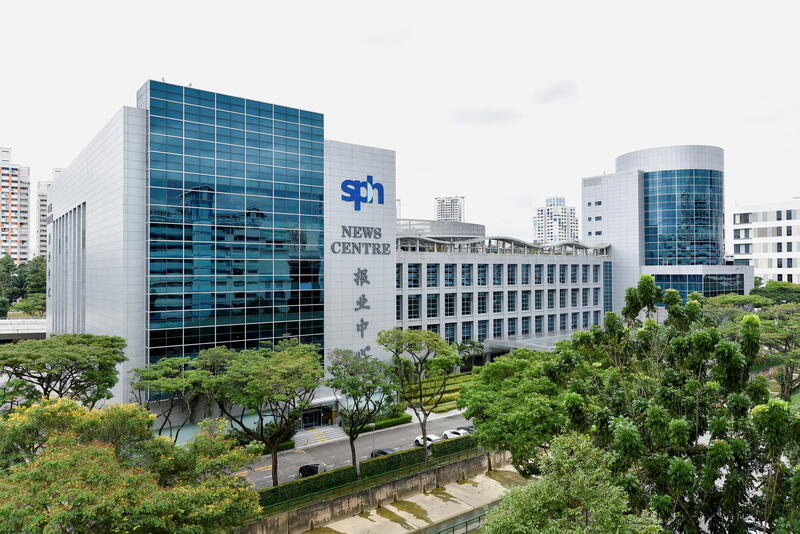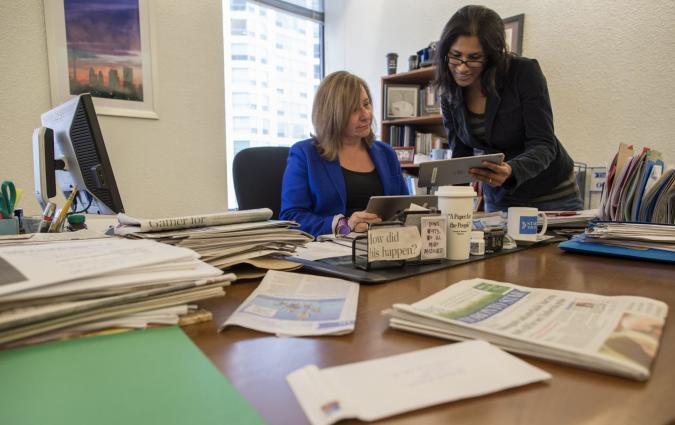In this piece
Opportunities and challenges for retaining trust in Singapore’s state-funded media

A view of the Singapore Press Holdings Ltd (SPH) office in Singapore. REUTERS/Caroline Chia
In this piece
Defining the problems | Trust-winning measures | Government facing measures | Public-facing measures | Newsroom-facing measuresIn February 2022, Singapore’s Minister for Communications and Information, Josephine Teo, announced that her ministry had set aside S$900 million (£555m) in funding support for Singapore Press Holdings Media Trust (SMT) over the next five years.
“The Government's key interest is to ensure the reach of SPH Media Trust's products. No one gains if these products lack credibility and are ignored by audiences,” she said. “It is because the public sees them as trusted sources of news that we must do all we can to keep them as viable propositions.”
SMT, a not-for-profit holding company of SPH Media, publishes English daily The Straits Times, Chinese daily Lianhe Zaobao, Malay daily Berita Harian and Tamil daily Tamil Murasu, among other titles. The trust was spun off from newspaper publisher and mainboard-listed company Singapore Press Holdings (SPH) in December 2021, as the once-most profitable newspaper company in the world struggled to keep its media business afloat.
SMT is not the only media outlet with government ties in Singapore: Mediacorp, which received $310 million annually in public funding in the five years preceding 2020, is owned by state holding company, Temasek Holdings. And government funding of news media is common in many places, especially in European countries. For example, the French government spends hundreds of millions of euros annually to support the press, including prominent papers like Le Monde and Le Figaro. It has done so for over half a century, now through its Presse et Pluralisme program which distributed €483 million in subsidies between 2020 and 2022, according to the Ministry of Culture.
But Singaporean media watchers and practitioners worry the uneasy act of balancing editorial and political pulls is becoming more difficult.
Defining the problems
To better understand the problems, constraints, and obstacles facing SPH Media as it undergoes restructuring, I spoke with former and current journalists, as well as senior editors of The Straits Times and Lianhe Zaobao to find out the challenges they encountered in the course of their work.
The interviewees spoke to me in their personal capacity, not for the organisation. I have withheld their identities to preserve their candour.
Between them, they identified four existing areas of concern, among which points one and four might be exacerbated by state funding:
- A culture of deference to authority in the newsrooms
- A lack of communication between journalists and editors
- A deterioration of journalistic standards
- Increasing control from government communication teams
Overall, journalists felt they could be doing more to push the envelope but felt that they couldn’t. I took these concerns to Lee Huay Leng, the editor-in-chief of SPH Media’s Chinese Media Group who oversees Lianhe Zaobao (my employer) and Shin Min Daily News, among other Chinese-language titles.
Her response was that she felt journalists were not doing enough to push the envelope. “There are some realities in our media scene,” she told me. “I do not think we are entirely free, but our journalists have also not been fighting hard enough. So, I will spend time talking to journalists to better sense what [they] think, and I need to re-ignite the idealism in them.”
Earning public trust has been and always will be a challenge, she said. “This friction will be there for a while – being credible, convincing people we are credible, and explaining our relationship with the state. That struggle to reconcile will always be there,” she said. But the automatic assumption that editors toe the line was unfounded. “I know for myself that I exercise judgment in the course of my work,” she said.
She also said that the Ministry of Communications and Information had been clear that the funding should not change the relationship with the press: “[Minister Teo] had talked to her press officers, telling them that nothing has changed, that the relationship between them and us has not changed [after the restructuring]. Their funding us does not mean we are at their beck and call. We are very mindful of this; you do not give us orders just because you give us money.”
Proof of this, she said, would be found in the editorial content. “Looking at our op-eds and news reports in the last year, does anyone think we are receiving instructions from the top? I don't think so,” she said. “Look at how we cover the next general election and presidential election. Readers can judge us then because this is the most direct way of assessing us.”
Trust-winning measures
I asked media scholars, editors, and journalists for their thoughts on what practical steps might be taken by SPH Media to secure its reputation as a credible and independent media organisation after the restructuring. Their answers can be broadly categorised into government-facing, public-facing, and newsroom-facing measures.
Government facing measures
1. Working with other media houses to redefine the role of Singaporean media in 2023: is nation-building still our primary function, or is it time to move to a public interest role?
2. Reset the relationship with government communications officers. Journalists I spoke to said they would like an end to “micro-managed news coverage” and more trust that journalists have the public interest at heart.
Public-facing measures
1. Introduce an editorial code. Bertha Henson drew up a Code of Ethics for journalists in Singapore on 13 November 2021. Among other things, it calls for a government-media relationship that is based on respect for the role each party plays.
2. Introduce a Readers’ Editor. A Readers’ Editor, also known as Public Editor or Standards Editor, is a role that is usually independent of the newsroom, reporting to the publisher. They have responsibility for holding the newsroom to account for its journalistic standards, adjudicating public complaints about the media outlet’s journalism, investigating claims of error brought forward by readers and news sources, and publishing necessary corrections on all platforms.
3. Introduce an independent council. Cherian George suggested setting up a well-resourced independent press council investigating complaints about professional ethics violations. He also called for an independent body insulated from government interference to disburse funds to SPH Media. Communications Professor Ang Peng Hwa from Singapore’s Nanyang Technological University pointed to examples in Scandinavian countries such as Denmark, where government funding models have worked because they appoint an independent third party to receive and distribute funds to news organisations. “This is important because the governments cannot put pressure on the newspaper to cover them favourably, for example,” he said.
4. Introduce public forums or readers’ panels. To build more transparency and trust, newsrooms could consider hosting regular conversations with their readers to foster greater understanding and increase media literacy. At KURIER, a German-language paper operating out of Vienna, they tested the idea of a “readers’ panel”, in which it would select groups of 10 readers to come to the newsroom for conversations with its editor-in-chief.
5. Disclosure of fund allocation and progress reports. As SPH Media submits half-yearly progress updates on three key performance indicators that the government stipulated, some interviewees proposed publishing these reports to defend its spending of taxpayers’ money. Some also called for full transparency by disclosing the use of funds to instil greater public confidence.
6. Show your legwork. When government officials sideline journalists or are unresponsive to requests for information, most interviewees said reporters should show readers that they have done their due diligence in the news-gathering process. This means journalists should include details such as who they approached, what they asked and whether questions were answered.
Other journalists said news organisations should also be upfront about any edits made to online news stories (including changes to headlines, quotes or captions) by adding disclaimers or footnotes, as more readers consume news online. Currently, Lianhe Zaobao does not have this practice.
Newsroom-facing measures
1. Improve communication between editors and journalists. Within newsrooms, interviewees agreed that editors and journalists need to strengthen communication by having open and frank discussions about news reporting and other editorial considerations. Journalists need to know their editors have their backs, and leaders need to do a better of job of clearly communicating their goals to journalists. “There is a set of metrics against which the government is measuring SPH Media,” one journalist said. “You need to communicate how those metrics translate into specific targets at the operational level.”
2. Strengthen mentorship. Some interviewees proposed investing more resources to guide inexperienced or younger journalists and stamp out undue self-censorship. Journalists told me their younger and inexperienced colleagues lacked the journalistic rigour to contextualise stories or pose questions to newsmakers in a critical way. And structural factors like the 24/7 online news cycle and producing multimedia packages leaves less time for critical political coverage.
Most of the issues raised in my project (see full PDF) fundamentally centre on the competing challenges of meeting readers’ needs and interests and maintaining a productive relationship with a government set on controlling the public narrative.
The hard truth is that SPH Media can probably never stop this delicate balancing act. But however precarious navigating this difficult terrain might be, it is paramount that the company and the government take concrete steps to retain hearts and minds under the new model, or both will risk losing relevance.
As Minister Teo eloquently put it: “No one gains if these products lack credibility and are ignored by audiences.” That includes the Singaporean government.




